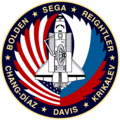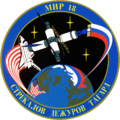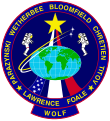Program Shuttle-Mir
Program Shuttle-Mir - wspólny program kosmiczny Rosji i Stanów Zjednoczonych, którego celem była realizacja długoterminowych wypraw na rosyjską stację kosmiczną Mir. W ramach tej współpracy transport rosyjskich kosmonautów był dokonywany przez amerykańskie wahadłowce, a amerykańskich astronautów przez rosyjskie pojazdy kosmiczne Sojuz.
Program, określany również jako „Faza Pierwsza”, został powołany, aby umożliwić Stanom Zjednoczonym korzystanie z doświadczenia Rosjan w długoterminowych lotach kosmicznych, a także miał za zadanie wpłynąć na obudzenie ducha współpracy między dwoma narodami i ich agencjami kosmicznymi – NASA i Roskosmosem. W dalszej perspektywie czasu miało to wpłynąć na przyszłą współpracę przy kosmicznych przedsięwzięciach, szczególnie przy „Fazie Drugiej”, czyli budowie Międzynarodowej Stacji Kosmicznej. Ogłoszenie programu miało miejsce w 1993 roku. Pierwsza misja w jego ramach odbyła się rok później, a program był kontynuowany do 1998 roku, po odbyciu zaplanowanych jedenastu misji wahadłowców. W trakcie siedmiu wypraw z tego okresu, amerykańscy astronauci spędzili niemal 1000 dni w kosmosie.
Podczas czterech lat trwania programu, zostało ustanowionych wiele rekordów, m.in.: pierwszy amerykański astronauta na pokładzie statku Sojuz, na największy latający pojazd kosmiczny czy też pierwszy spacer kosmiczny amerykańskiego astronauty w rosyjskim kombinezonie klasy Orłan.
Realizacja programu wiązała się z wieloma obawami, szczególnie bezpieczeństwa stacji „Mir” po pożarze i kolizji na pokładzie, kwestii finansowych związanych z brakiem środków na Rosyjski Program Kosmiczny oraz zaniepokojeniem astronautów postawą administratorów wobec całego programu. Niemniej jednak, dzięki połączonym działaniom dwóch agencji kosmicznych, została pozyskana duża ilość wiedzy na temat budowy stacji orbitalnej oraz pracy kooperacyjnej przy kosmicznych przedsięwzięciach, zmniejszając tym samym ilość potencjalnych trudności podczas konstruowania Międzynarodowej Stacji Kosmicznej (ISS).
Misje
Linki zewnętrzne
- Historia programu Shuttle-Mir. spaceflight.nasa.gov. [zarchiwizowane z tego adresu (2015-11-30)]. (NASA)
Media użyte na tej stronie
STS-79 was the fourth in a series of NASA docking missions to the Russian Mir Space Station, leading up to the construction and operation of the International Space Station (ISS). As the first flight of the Spacehab Double Module, STS-79 encompassed research, test and evaluation of ISS, as well as logistics resupply for the Mir Space Station. STS-79 was also the first NASA-Mir American crew member exchange mission, with John E. Blaha (NASA-Mir-3) replacing Shannon W. Lucid (NASA-Mir-2) aboard the Mir Space Station. The lettering of their names either up or down denotes transport up to the Mir Space Station or return to Earth on STS-79. The patch is in the shape of the Space Shuttle's airlock hatch, symbolizing the gateway to international cooperation in space. The patch illustrates the historic cooperation between the United States and Russia in space. With the flags of Russia and the United States as a backdrop, the handshake of Extravehicular Mobility Unit (EMU) which are suited crew members symbolizes mission teamwork, not only of the crew members but also the teamwork between both countries space personnel in science, engineering, medicine and logistics.
STS-60 crew patch
- The design of the crew patch for NASA's STS-60 mission depicts the Space Shuttle Discovery's on-orbit configuration. The American and Russian flags symbolize the partnership of the two countries and their crew members taking flight into space together for the first time. The open payload bay contains: the Space Habitation Module (Spacehab), a commercial space laboratory for life and material science experiments; and a Getaway Special Bridge Assembly in the aft section carrying various experiments, both deployable and attached. A scientific experiment to create and measure an ultra-vacuum environment and perform semiconductor material science – the Wake Shield Facility – is shown on the Remote Manipulator System (RMS) prior to deployment.
* In the STS-89 crew insignia, the link between the United States and Russia is symbolically represented by the Space Shuttle Endeavour and Russia's Mir Space Station orbiting above the Bering Strait between Siberia and Alaska. The success of the joint United States-Russian missions is depicted by the Space Shuttle and Mir colored by the rising sun in the background.
- A shadowed representation of the International Space Station (ISS) rising with the sun represents the future program for which the Shuttle-Mir missions are prototypes. The inside rim of the insignia describes the outline of the number eight representing STS-89 as the eighth Shuttle/Mir docking mission.
- The nine stars represent the nine joint missions to be flown of the program and when combined with the number eight in the rim, reflect the mission number. The nine stars also symbolize the children of the crew members who will be the future beneficiaries of the joint development work of the space programs of the two countries.
- Along the rim are the crew members' names with David A. Wolf's name on the left and Andrew S. W. Thomas' name on the right, the returning and upgoing cosmonaut guest researcher crew members. In between and at the bottom is the name of Salizan S. Sharipov, payload specialist representing Russian Space Agency (RSA), in Cyrillic alphabet.
- The other crew members are Terrence W. Wilcutt, commander; Joe F. Edwards, Jr., pilot; and mission specialists Michael P. Anderson, Bonnie J. Dunbar, and James F. Reilly. The red, white and blue of the rim reflect the colors of the American and Russian flags which are also represented in the rim on either side of the joined spacecraft.
The crew patch for STS-81 , the fifth Shuttle-Mir docking mission, is shaped to represent the Roman numeral V. The Shuttle Atlantis is launching toward a rendezvous with Russia's Mir Space Station, silhouetted in the background. Atlantis and the STS-81 crew spent several days docked to Mir during which time Jerry M. Lineger (NASA-Mir-4) replaced astronaut John Blaha (NASA-Mir-3) as the U.S. crew member onboard Mir. The U.S. and Russian flags are depicted along with the names of the shuttle crew.
The STS-86 flight was the seventh shuttle-Mir docking mission, symbolized by seven stars. The international crew includes astronauts from the United States, Russia, and France. The flags of these nations are incorporated in the rays of the astronaut logo. The rays of light streaking across the sky depict the orbital tracks of the two spacecraft as they prepare to dock. During the flight, an American astronaut and a Russian cosmonaut will perform an extravehicular activity (EVA). The mercator projection of Earth illustrates the global cooperative nature of the flight.
STS-63 Mission Insignia
STS-74 Mission Insignia
- The STS-74 crew patch depicts the orbiter Atlantis docked to the Russian Space Station Mir. The central focus is on the Russian-built docking module, drawn with shading to accentuate its pivotal importance to both STS-74 and the NASA-Mir Program. The rainbow across the horizon represents the Earth's atmosphere, the thin membrane protecting all nations, while the three flags across the bottom show those nations participating in STS-74: Russia, Canada, and the United States. The sunrise is symbolic of the dawn of a new era in NASA space flight , that of International Space Station construction.
STS-71 Mission Insignia
STS-76 Mission Insignia
The official NASA patch for the Shuttle-Mir Program, showing a Space Shuttle Orbiter docked to the Russian Space Station Mir, flying above a stylised Earth. The patch is bordered by the colours of the flags of Russia and the USA
The official crew patch for the Russian Soyuz TM-21 mission, which delivered the EO-18 crew to the space station Mir.
The STS-84 emblem depicts the Space Shuttle Atlantis launching into Earth orbit to join the Russian Space Station Mir as part of Phase One (Shuttle-Mir) of the International Space Station program. The names of the eight astronauts who flew onboard Atlantis, including the two who changed their positions onboard Mir for a long duration flight, are shown along the border of the patch. The STS-84/Mir-23 team will transfer 7,000 pounds of experiments, Station hardware, food and clothing to and from Mir during the five-day period of docking. The Phase One program is represented by the rising Sun and by the Greek letter Phi followed by one star. This sixth Shuttle-Mir docking mission is symbolized by the six stars surrounding the word Mir in Cyrillic characters. Combined, the seven stars symbolize the current configuration of Mir, composed of six modules launched by the Russians and one module brought up by Atlantis on a previous docking flight.
This is the crew patch for the STS-91 mission – the ninth flight of the Shuttle-Mir Phase One docking missions. The crew will bring back Andrew S. W. Thomas, the last long-duration American crew member flown on the Russian Space Station Mir. This mission marks the end of the Shuttle-Mir Phase One Program and will open the way for Phase Two: construction of the International Space Station (ISS).
The crew patch depicts the rendezvous of the Space Shuttle Discovery with the Space Station Mir. The flags of the United States and Russia are displayed at the top of the patch and both countries are visible on the Earth behind the two spacecraft. The names of the American crew members surround the insignia on the outer areas, with the name of cosmonaut Valeriy Ryumin in Cyrillic at the lower right.


























